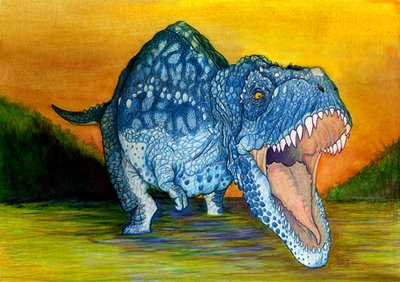
One thing I have witnessed paleo-artists doing is 'fleshing out' skeletons. They will take an image of a skeleton (drawn or actual photograph)and use tracing paper as an overlay to add muscles and then a second drawing detailing what they 'think' the creature looked like.

(Image from www.dakotadino.com/General_Info.htm as a sample image. I'll post the actual skeleton I used when I locate the picture.) Make sure to pick an image that is interesting for more drama after some initial practice on more static poses!
Now keep in mind that many fossils are very incomplete (some consisting of a single tooth or less) so there can be a great deal of guesswork into just figuring out what the skeleton looks like. Tie that into the fact that we haven't witnessed too many of the critters running down mainstreet, and you have a great opportunity to let your imagination run wild! Be careful to do searches on skeletons or skulls so as not to involve another artist's design! (More about a 'guesswork' exercise highlighting this aspect later that will leave you stunned and amazed...maybe.)
Here is another prismacolor rendering (used on dino and water) with a watercolor background. Watercolor can be a bit difficult to work with on illustration board as it will leave 'paper balls' on the surface if you work too fast saturating the top layers of the board. Makes sure to take your time with WC on this material! Cotton-rag paper is something I prefer to use when I know I will be using watercolor, as it will 'hold' the paint better (less blooming of the color)and eliminate the skinning of the substrate.
A tip that I picked up when using colored pencils: The pigment is 'held' in a waxy substance. Over time, this substance will leech to the top (known as a 'wax bloom') and dull the intensity of the work. To prevent this, spray the finished drawing with a fixative! This will help cut the wax bloom and keep your colors intense.

No comments:
Post a Comment